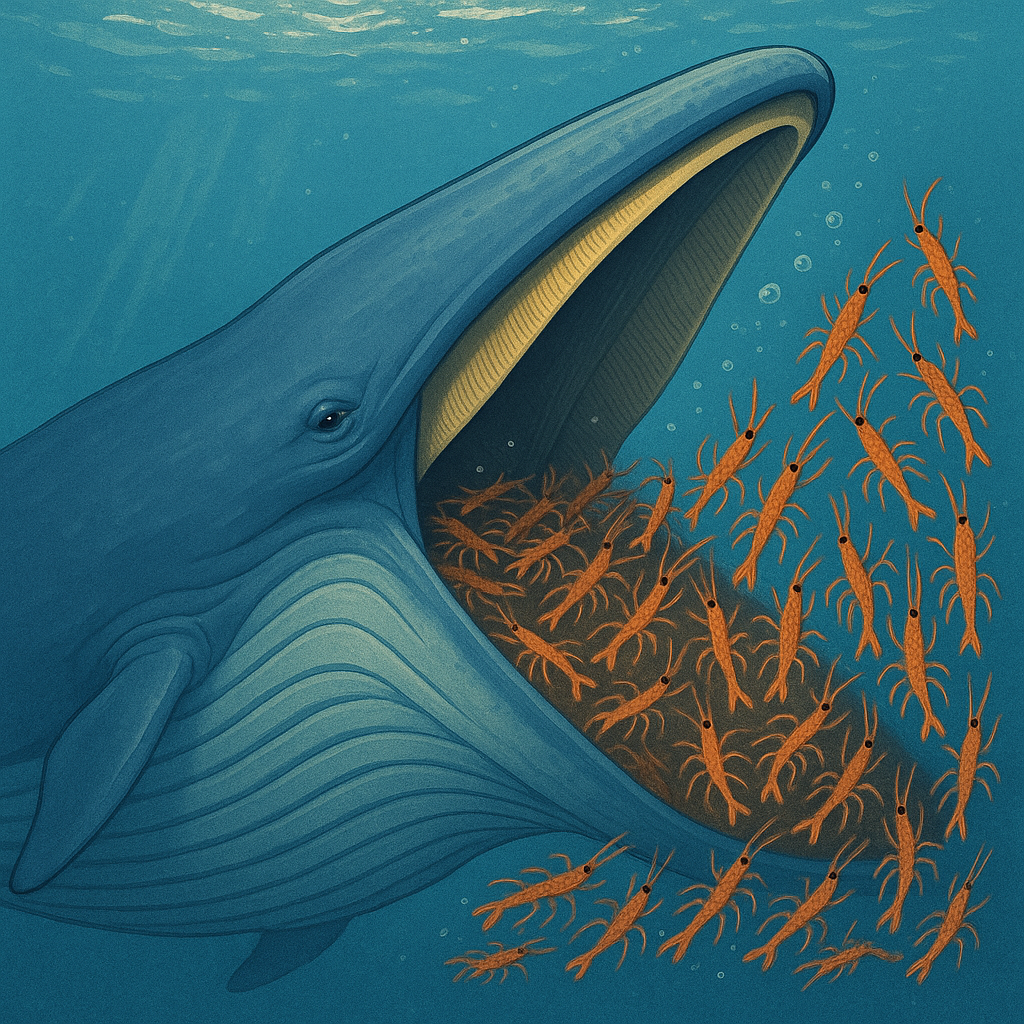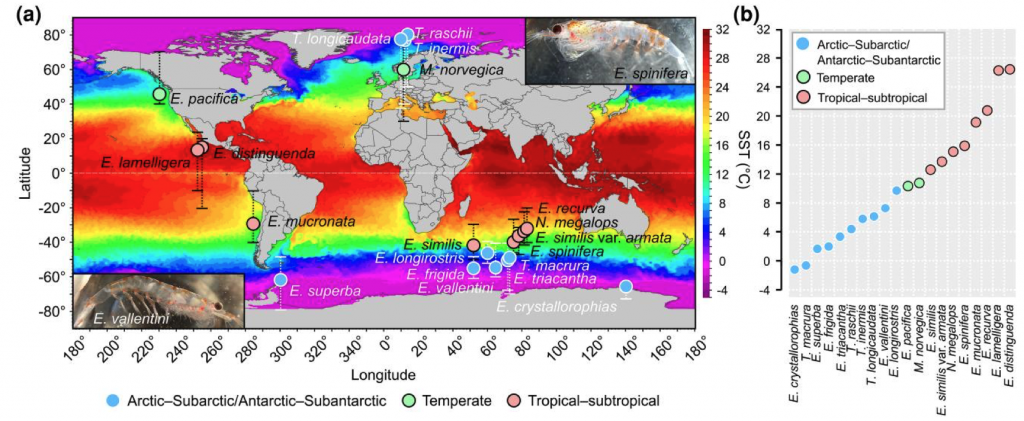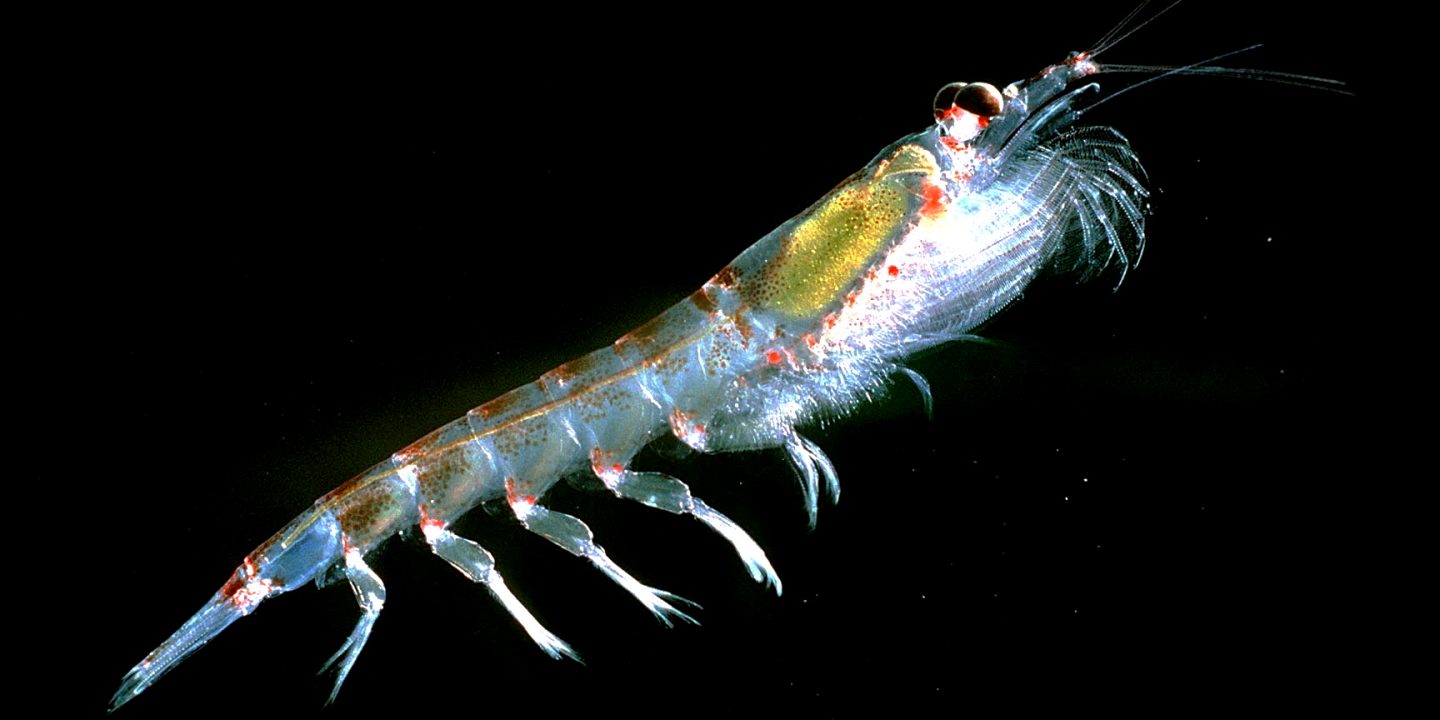Featured photo: Euphausia superba, the Antarctic krill. Photo by Professor Dr. habil. Uwe Kils, uploaded to en.wikipedia.org. This file is licensed under the Creative Commons Attribution-Share Alike 3.0 Unported license. https://creativecommons.org/licenses/by-sa/3.0/
Tiny but mighty, krill are among the most abundant animals on Earth and their collective role is vital to ocean health and the global climate.
Krill are small shrimp-like crustaceans found throughout the world’s oceans, from icy polar seas to warm tropical waters. Although each individual is relatively small, up to 6 cm long, krill are some of the most abundant animals on Earth. Collectively, they form a crucial link in marine ecosystems, connecting microscopic plankton at the base of the food web to larger predators like fish, seabirds, seals, and whales.
With about 86 known species, krill vary widely in size, lifespan, and habitat. Some, like the most famous Antarctic krill (Euphausia superba), form massive swarms visible from space. Others live in mid-latitude or tropical regions. This diversity means krill influence marine food webs globally, sustaining fisheries and maintaining ecosystem health. While krill species exist in oceans worldwide, their greatest abundance and diversity are found in the Southern Ocean, where they play a particularly critical role in sustaining marine ecosystems. Some species also thrive in the northern oceans, contributing to food webs there as well.
Why krill matter: Ecology and climate
Krill are vital for ocean life. Many predators depend on them for food: a single crabeater seal (also known as krill-eater) can eat over 10,000 krill daily, while the blue whale – the largest animal ever – can consume millions in a single meal.

Krill also play an important role in the global carbon cycle. Feeding on phytoplankton, which absorb carbon dioxide from the atmosphere, krill help transport carbon to the deep ocean through their sinking fecal pellets and molted shells. This biological “carbon pump” helps lock away CO₂, mitigating climate change.
Harvesting Krill: Economic value and ecological risks
Krill are increasingly harvested, primarily for their oil rich in omega-3 fatty acids, used in dietary supplements and pharmaceuticals. The krill fishery, especially in the Southern Ocean, is one of the fastest-growing globally, supplying products like krill oil capsules, animal feed additives, and aquaculture feed.

While economically valuable, krill harvesting raises ecological concerns. Overfishing risks reducing food availability for predators and disrupting Southern Ocean ecosystems. Sustainable management and careful monitoring are critical to protect krill populations and preserve their ecological and climate roles.
Challenges in a changing Ocean
Despite their numbers, krill face growing threats from climate warming, sea ice loss, ocean acidification, pollutions, and expanding fisheries. Many krill species depend on stable conditions during early development stages; for example, Antarctic krill larvae rely on sea ice for shelter and feeding. As habitats shrink or shift, krill populations may decline, putting entire marine ecosystems at risk.
Understanding krill adaptation through genomics: our research
To understand how krill might cope with rapid environmental changes, we conducted a large-scale genomic study of 20 krill species sampled worldwide – from tropical seas to polar oceans.
Using transcriptome sequencing—a method focusing on active genes—we revealed patterns of genetic diversity, species differences, and signals of adaptation across this diverse group.


Key discoveries:
- New insights in species diversity: We found that Euphausia similis from the Indian Ocean actually consists of two distinct species, one previously unrecognized. Identifying such hidden diversity is crucial for conservation and ecosystem management, as different species may carry different genes and respond in distinct ways to environmental change.
- Diversity and life history: Smaller, short-lived krill species show much higher genetic diversity than large, long-lived Antarctic species, suggesting greater adaptive potential.
- Genetic signatures of adaptation to the cold: Antarctic krill and relatives have specific molecular adaptations in genes linked to temperature sensing and ion regulation—key for survival in freezing waters.
- Limits to adaptation: Some Antarctic krill species exhibit lower rates of adaptive evolution, possibly due to the extensive mixing of their huge populations, which might restrict their ability to quickly respond to environmental change.
What this means for our oceans
Our results suggest that while some krill species may have the genetic capacity to adapt to a changing climate, others—especially the iconic Antarctic krill—could face limits in their ability to evolve quickly. This matters not just for krill, but for the countless species that depend on them. By studying a broad range of krill from oceans worldwide, we can build a clearer picture of how marine ecosystems respond to environmental stress—and better anticipate the consequences of climate change.
Check out this cool video from WWF on the Antarctic Krill:
![]()

